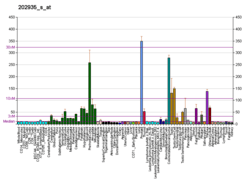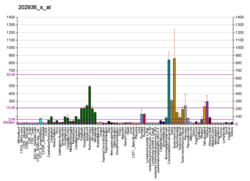SOX9
Transcription factor SOX-9 is a protein that in humans is encoded by the SOX9 gene.[5][6]
Function
SOX-9 recognizes the sequence CCTTGAG along with other members of the HMG-box class DNA-binding proteins. It acts during chondrocyte differentiation and, with steroidogenic factor 1, regulates transcription of the anti-Müllerian hormone (AMH) gene.[6]
SOX-9 also plays a pivotal role in male sexual development; by working with Sf1, SOX-9 can produce AMH in Sertoli cells to inhibit the creation of a female reproductive system.[7] It also interacts with a few other genes to promote the development of male sexual organs. The process starts when the transcription factor Testis determining factor (encoded by the sex-determining region SRY of the Y chromosome) activates SOX-9 activity by binding to an enhancer sequence upstream of the gene.[8] Next, Sox9 activates FGF9 and forms feedforward loops with FGF9[9] and PGD2.[8] These loops are important for producing SOX-9; without these loops, SOX-9 would run out and the development of a female would almost certainly ensue. Activation of FGF9 by SOX-9 starts vital processes in male development, such as the creation of testis cords and the multiplication of Sertoli cells.[9] The association of SOX-9 and Dax1 actually creates Sertoli cells, another vital process in male development.[10]
Clinical significance
Mutations lead to the skeletal malformation syndrome campomelic dysplasia, frequently with autosomal sex-reversal[6] and cleft palate.[11]
SOX9 sits in a gene desert on 17q24 in humans. Deletions, disruptions by translocation breakpoints and a single point mutation of highly conserved non-coding elements located > 1 Mb from the transcription unit on either side of SOX9 have been associated with Pierre Robin Sequence, often with a cleft palate.[11][12]
Role in sex reversal
Mutations in Sox9 or any associated genes can cause reversal of sex and hermaphroditism (or intersexuality in humans). If Fgf9, which is activated by Sox9, is not present, a fetus with both X and Y chromosomes can develop female gonads;[8] the same is true if Dax1 is not present.[10] The related phenomena of hermaphroditism can be caused by unusual activity of the SRY, usually when it's translocated onto the X-chromosome and its activity is only activated in some cells.[13]
Interactions
SOX9 has been shown to interact with Steroidogenic factor 1,[7] MED12[14] and MAF.[15]
See also
References
- 1 2 3 GRCh38: Ensembl release 89: ENSG00000125398 - Ensembl, May 2017
- 1 2 3 GRCm38: Ensembl release 89: ENSMUSG00000000567 - Ensembl, May 2017
- ↑ "Human PubMed Reference:".
- ↑ "Mouse PubMed Reference:".
- ↑ Tommerup N, Schempp W, Meinecke P, Pedersen S, Bolund L, Brandt C, Goodpasture C, Guldberg P, Held KR, Reinwein H, et al. (Sep 1993). "Assignment of an autosomal sex reversal locus (SRA1) and campomelic dysplasia (CMPD1) to 17q24.3-q25.1". Nat Genet. 4 (2): 170–4. doi:10.1038/ng0693-170. PMID 8348155.
- 1 2 3 "Entrez Gene: SOX9 SRY (sex determining region Y)-box 9 (campomelic dysplasia, autosomal sex-reversal)".
- 1 2 De Santa Barbara P, Bonneaud N, Boizet B, Desclozeaux M, Moniot B, Sudbeck P, Scherer G, Poulat F, Berta P (November 1998). "Direct interaction of SRY-related protein SOX9 and steroidogenic factor 1 regulates transcription of the human anti-Müllerian hormone gene". Mol. Cell. Biol. 18 (11): 6653–65. doi:10.1128/mcb.18.11.6653. PMC 109250. PMID 9774680.
- 1 2 3 Moniot B, Declosmenil F, Barrionuevo F, Scherer G, Aritake K, Malki S, Marzi L, Cohen-Solal A, Georg I, Klattig J, Englert C, Kim Y, Capel B, Eguchi N, Urade Y, Boizet-Bonhoure B, Poulat F (June 2009). "The PGD2 pathway, independently of FGF9, amplifies SOX9 activity in Sertoli cells during male sexual differentiation". Development. 136 (11): 1813–21. doi:10.1242/dev.032631. PMC 4075598. PMID 19429785.
- 1 2 Kim Y, Kobayashi A, Sekido R, DiNapoli L, Brennan J, Chaboissier MC, Poulat F, Behringer RR, Lovell-Badge R, Capel B (June 2006). "Fgf9 and Wnt4 act as antagonistic signals to regulate mammalian sex determination". PLoS Biol. 4 (6): e187. doi:10.1371/journal.pbio.0040187. PMC 1463023. PMID 16700629.
- 1 2 Bouma GJ, Albrecht KH, Washburn LL, Recknagel AK, Churchill GA, Eicher EM (July 2005). "Gonadal sex reversal in mutant Dax1 XY mice: a failure to upregulate Sox9 in pre-Sertoli cells". Development. 132 (13): 3045–54. doi:10.1242/dev.01890. PMID 15944188.
- 1 2 Dixon MJ, Marazita ML, Beaty TH, Murray JC (March 2011). "Cleft lip and palate: understanding genetic and environmental influences". Nat. Rev. Genet. 12 (3): 167–78. doi:10.1038/nrg2933. PMC 3086810. PMID 21331089.
- ↑ Benko S, Fantes JA, Amiel J, Kleinjan DJ, Thomas S, Ramsay J, Jamshidi N, Essafi A, Heaney S, Gordon CT, McBride D, Golzio C, Fisher M, Perry P, Abadie V, Ayuso C, Holder-Espinasse M, Kilpatrick N, Lees MM, Picard A, Temple IK, Thomas P, Vazquez MP, Vekemans M, Roest Crollius H, Hastie ND, Munnich A, Etchevers HC, Pelet A, Farlie PG, Fitzpatrick DR, Lyonnet S (March 2009). "Highly conserved non-coding elements on either side of SOX9 associated with Pierre Robin sequence". Nat. Genet. 41 (3): 359–64. doi:10.1038/ng.329. PMID 19234473.
- ↑ Margarit E, Coll MD, Oliva R, Gómez D, Soler A, Ballesta F (January 2000). "SRY gene transferred to the long arm of the X chromosome in a Y-positive XX true hermaphrodite". Am. J. Med. Genet. 90 (1): 25–8. doi:10.1002/(SICI)1096-8628(20000103)90:1<25::AID-AJMG5>3.0.CO;2-5. PMID 10602113.
- ↑ Zhou R, Bonneaud N, Yuan CX, de Santa Barbara P, Boizet B, Schomber T, Scherer G, Roeder RG, Poulat F, Berta P, Tibor S (July 2002). "SOX9 interacts with a component of the human thyroid hormone receptor-associated protein complex". Nucleic Acids Res. 30 (14): 3245–52. doi:10.1093/nar/gkf443. PMC 135763. PMID 12136106.
- ↑ Huang W, Lu N, Eberspaecher H, De Crombrugghe B (December 2002). "A new long form of c-Maf cooperates with Sox9 to activate the type II collagen gene". J. Biol. Chem. 277 (52): 50668–75. doi:10.1074/jbc.M206544200. PMID 12381733.
Further reading
- Ninomiya S, Narahara K, Tsuji K, et al. (1995). "Acampomelic campomelic syndrome and sex reversal associated with de novo t(12;17) translocation". Am. J. Med. Genet. 56 (1): 31–4. doi:10.1002/ajmg.1320560109. PMID 7747782.
- Lefebvre V, de Crombrugghe B (1998). "Toward understanding SOX9 function in chondrocyte differentiation". Matrix Biol. 16 (9): 529–40. doi:10.1016/S0945-053X(98)90065-8. PMID 9569122.
- Harley VR (2002). "The molecular action of testis-determining factors SRY and SOX9". Novartis Found. Symp. 244: 57–66, discussion 66–7, 79–85, 253–7. doi:10.1002/0470868732.ch6. PMID 11990798.
- Kwok C, Weller PA, Guioli S, et al. (1995). "Mutations in SOX9, the gene responsible for Campomelic dysplasia and autosomal sex reversal". Am. J. Hum. Genet. 57 (5): 1028–36. PMC 1801368. PMID 7485151.
- Foster JW, Dominguez-Steglich MA, Guioli S, et al. (1995). "Campomelic dysplasia and autosomal sex reversal caused by mutations in an SRY-related gene". Nature. 372 (6506): 525–30. doi:10.1038/372525a0. PMID 7990924.
- Wagner T, Wirth J, Meyer J, et al. (1995). "Autosomal sex reversal and campomelic dysplasia are caused by mutations in and around the SRY-related gene SOX9". Cell. 79 (6): 1111–20. doi:10.1016/0092-8674(94)90041-8. PMID 8001137.
- Südbeck P, Schmitz ML, Baeuerle PA, Scherer G (1996). "Sex reversal by loss of the C-terminal transactivation domain of human SOX9". Nat. Genet. 13 (2): 230–2. doi:10.1038/ng0696-230. PMID 8640233.
- Cameron FJ, Hageman RM, Cooke-Yarborough C, et al. (1997). "A novel germ line mutation in SOX9 causes familial campomelic dysplasia and sex reversal". Hum. Mol. Genet. 5 (10): 1625–30. doi:10.1093/hmg/5.10.1625. PMID 8894698.
- Meyer J, Südbeck P, Held M, et al. (1997). "Mutational analysis of the SOX9 gene in campomelic dysplasia and autosomal sex reversal: lack of genotype/phenotype correlations". Hum. Mol. Genet. 6 (1): 91–8. doi:10.1093/hmg/6.1.91. PMID 9002675.
- Cameron FJ, Sinclair AH (1997). "Mutations in SRY and SOX9: testis-determining genes". Hum. Mutat. 9 (5): 388–95. doi:10.1002/(SICI)1098-1004(1997)9:5<388::AID-HUMU2>3.0.CO;2-0. PMID 9143916.
- Wunderle VM, Critcher R, Hastie N, et al. (1998). "Deletion of long-range regulatory elements upstream of SOX9 causes campomelic dysplasia". Proc. Natl. Acad. Sci. U.S.A. 95 (18): 10649–54. doi:10.1073/pnas.95.18.10649. PMC 27949. PMID 9724758.
- De Santa Barbara P, Bonneaud N, Boizet B, et al. (1998). "Direct interaction of SRY-related protein SOX9 and steroidogenic factor 1 regulates transcription of the human anti-Müllerian hormone gene". Mol. Cell. Biol. 18 (11): 6653–65. doi:10.1128/mcb.18.11.6653. PMC 109250. PMID 9774680.
- McDowall S, Argentaro A, Ranganathan S, et al. (1999). "Functional and structural studies of wild type SOX9 and mutations causing campomelic dysplasia". J. Biol. Chem. 274 (34): 24023–30. doi:10.1074/jbc.274.34.24023. PMID 10446171.
- Huang W, Zhou X, Lefebvre V, de Crombrugghe B (2000). "Phosphorylation of SOX9 by cyclic AMP-dependent protein kinase A enhances SOX9's ability to transactivate a Col2a1 chondrocyte-specific enhancer". Mol. Cell. Biol. 20 (11): 4149–58. doi:10.1128/MCB.20.11.4149-4158.2000. PMC 85784. PMID 10805756.
- Thong MK, Scherer G, Kozlowski K, et al. (2000). "Acampomelic campomelic dysplasia with SOX9 mutation". Am. J. Med. Genet. 93 (5): 421–5. doi:10.1002/1096-8628(20000828)93:5<421::AID-AJMG14>3.0.CO;2-5. PMID 10951468.
- Ninomiya S, Yokoyama Y, Teraoka M, et al. (2001). "A novel mutation (296 del G) of the SOX90 gene in a patient with campomelic syndrome and sex reversal". Clin. Genet. 58 (3): 224–7. doi:10.1034/j.1399-0004.2000.580310.x. PMID 11076045.
- Preiss S, Argentaro A, Clayton A, et al. (2001). "Compound effects of point mutations causing campomelic dysplasia/autosomal sex reversal upon SOX9 structure, nuclear transport, DNA binding, and transcriptional activation". J. Biol. Chem. 276 (30): 27864–72. doi:10.1074/jbc.M101278200. PMID 11323423.
External links
- SOX9+protein,+human at the US National Library of Medicine Medical Subject Headings (MeSH)
- SOX9 human gene location in the UCSC Genome Browser.
- SOX9 human gene details in the UCSC Genome Browser.
This article incorporates text from the United States National Library of Medicine, which is in the public domain.






